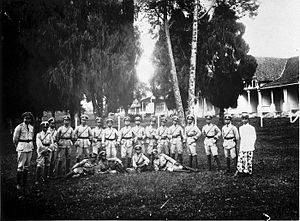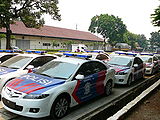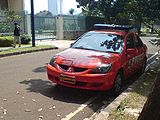- Indonesian National Police
-
Indonesian National Police
Kepolisian Negara Republik IndonesiaAbbreviation POLRI Logo of Indonesian National Police Motto Rastra Sewakottama People's Main Servant Agency overview Legal personality Governmental: Government agency Jurisdictional structure National agency
(Operations jurisdiction)Indonesia Legal jurisdiction National General nature Operational structure Headquarters Jakarta, Indonesia Agency executive General Timur Pradopo, Chief of Indonesian National Police Website www.polri.go.id The Indonesian National Police (Indonesian: Kepolisian Negara Republik Indonesia) is the official police force for Indonesia. It had formerly been a part of the Tentara Nasional Indonesia. The police were formally separated from the military in April 1999, a process which was formally completed in July 2000.[1] With 150,000 personnel, the police form a much smaller portion of the population than in most nations. The total number of national and local police in 2006 was approximately 470,000.
The strength of the Indonesian National Police stood at approximately 285,000 in 2004. The national police force was formally separated as a branch of the armed forces and placed under the Office of the President in 1999. It also includes 12,000 marine police and an estimated 40,000 People’s Security (Kamra) trainees who serve as a police auxiliary and report for three weeks of basic training each year.
The Headquarter, known as Markas Besar/Mabes in Indonesian, is located in Kebayoran Baru, South Jakarta, Indonesia.
Contents
History
When large parts of Indonesia was under Dutch colonial occupation until 1940s, police duties were performed by either military establishments or colonial police known as the veldpolitie or the field police.[citation needed] Japanese occupation during WW II brought changes when the Japanese formed various armed organizations to support their war. This had led to the distribution of weapons to military trained youths, which were largely confiscated from the Dutch armory.
After the Japanese occupation, the national police became an armed organization.[citation needed] The Indonesian police was established in 1946, and its units fought in the Indonesian National Revolution against the invading Dutch forces. The police also participated in suppressing the 1948 communist revolt in Madiun. In 1966, the police was brought under the control of Armed Forces Chief. Following the proclamation of independence, the police played a vital role when they actively supported the people’s movement to dismantle the Japanese army, and to strengthen the defense of the newly created Republic of Indonesia. The police were not combatants who were required to surrender their weapons to the Allied Forces. During the revolution of independence, the police gradually formed into what is now known as Kepolisian Negara Republik Indonesia (Polri) or the Indonesian National Police. In 2000, the police force officially regained its independence and now is separate from the military.
Chief of Police (Kapolri)
- General R Said Soekanto Tjokrodiatmodjo (29 Sept 1945-14 Dec 1959)
- General Soekarno Djojonegoro (15 December 1959-29 December 1963)
- General Soetjipto Danoekoesoemo (30 December 1963-8 May 1965)
- General Soetjipto Joedodihardjo (9 May 1965-8 May 1968)
- General Hoegeng Imam Santoso (9 May 1968-2 October 1971)
- General Moch. Hasan (3 October 1971-1974)
- General Widodo Budidarmo (1974-25 September 1978)
- General Awaluddin Djamin (26 September 1978-1982)
- General Anton Sudjarwo (1982–1986)
- General Moch. Sanoesi (1986-19 February 1991)
- General Kunarto (20 February 1991-April 1993)
- General Banurusman Astrosemitro (April 1993-March 1996)
- General Dibyo Widodo (March 1996-28 June 1998)
- General Roesmanhadi (29 June 1998-3 January 2000)
- General Roesdihardjo (4 January 2000-22 September 2000)
- General Suroyo Bimantoro (23 September 2000-28 November 2001)
- General Da'i Bachtiar (29 November 2001-7 July 2005)
- General Sutanto (8 July 2005-30 September 2008)
- General Bambang Hendarso Danuri (30 September 2008-October 2010)
- General Timur Pradopo (October 2010- ...)
Organization
Polri is a centralised national bureaucracy.[2] As a national agency it has a large central headquarters in Jakarta (Markas Besar Polri or Mabes Polri). The regional police organisation parallels exactly the hierarchy of the Indonesian civic administration, with provincial police commands (Polisi Daerah or Polda) to cover provinces, district commands (Polisi Resor or Polres) for districts, sub-district commands (Polsek) and community police officers or Polmas to service individual villages.[3]
There are confusing terminological differences between some police commands. This derives from certain normative features of Indonesian governance. Indonesian political culture elevates the capital district (ibukota propinsi) of a province from other districts in the same province, though all have the same functional powers. Similarly, the capital province of the country (Jakarta), enjoys special normative status over other provinces – though in practice all have the same governmental responsibilities. The Indonesian police structure continues this by creating a special command for the province of Jakarta (Polda Metro Jaya), and special commands for capital city districts and cities (Polisi Kota Besar or Poltabes). Nevertheless, all of Indonesia’s police district commands (whether they are a Polres or Poltabes) and all the provincial commands (whether it is the flagship Polda Metro Jaya or one of the other Poldas) have the same powers and duties.[4]
As an additional complication, super large provinces like East, West and Central Java have intermediary coordinating commands (Polisi Wilayah or Polwil) designed to enhance coordination between provincial commands and districts (to illustrate, Polda Jawa Barat in West Java has no less than 29 district commands – a major challenge for command and control). However Polri has a stated commitment to dismantle these Polwil in the near future. .[5]
Internal police culture is doctrinaire and hierarchical, and the organisation reflects this.[6] The design and duties of Poldas and Polres are determined by central edict. [7] Current standing orders determine that all provincial police are divided into three streams A1 (Polda Metro Jaya), B1 (demographically large provinces like East, Central and West Java) and B2 (smaller provinces like Yogyakarta, or West Kalimantan). [8] The structure of these Poldas is more or less the same, with each possessing: a directorate of detectives, narcotics, traffic police, intelligence, specialist operational units (such as Brimob – the paramilitary police strikeforce, water police, and other units), as well as support detachments like the provosts, Binamitra (social relations police), etc. [9] What truly differentiates Poldas is their resource base. Within Polri a tripartite matrix is applied to allocate personnel, money and equipment. This matrix is based upon a provinces’ square area, population size and reported crime rate. The same matrix is also applied to divide resources between Polres. [10] Turning to examine the Polres, the Polres is in essence the backbone of the Indonesian police – it bridges the purely operational units (Polsek), with the higher planning/strategic elements of the structure (the Polda). In the Indonesian police a Polres is termed the Komando Satuan Dasar (or Basic Unit of Command); this means that a Polres has substantial autonomy to implement its own activities and mount its own operations. [11] Regarding the structure of a Polres, a Polres is in effect a scaled down version of a Polda. Below is a cross-section of an average B1 level Polres (discreetly termed Polres A), in the province of Yogyakarta. This data derives from a recent PhD dissertation. [12] Polres A has fourteen separate detachments. Seven of these detachments can be described as support elements. These support elements consist of: an Operations Planning Section, a Community Policing Section, an Administration Section (providing human resource management, training coordination, etc.), a Telecommunications detachment (providing communications support), a Unit P3D (provosts - or the police who police the police), a Police Service Centre (for coordinating requests from the public), a Medical Support Group and the Polres Secretariat. Based on 2007 data, these support areas were staffed by 139 personnel. The largest support unit was the Polres Service Centre, with fifty one police. These seven support elements back up the work of Polres A’s seven other operational units (or Opsnal in Polri terminology) as well as the nineteen sub-district police precincts in this particular district. [13]
The Opsnal and sub-district commands execute Polri’s operational tasks. Polres A has one Traffic Police Unit, one Vital/Strategic Object Protection Unit, one Police Patrol Unit, one Narcotics Investigation Unit, one Detective Unit, a special tourist protection taskforce and a Police Intelligence Unit. These detachments have a combined strength of 487 personnel. The largest numbers are in the patrol unit (178) and the traffic unit (143). Added to the Opsnal personnel at the Polres headquarters are 1288 other police in nineteen sub-district Polseks. In 2007 this gave Polres A a police-to-population ratio of around 1 police officer to 526 civilians. [14] Thus the Polres has a relatively large number of personnel, split across a breadth of operational roles, with a teeth-to-tail ratio between operational versus support personnel that is surprisingly high.
The allocation of the budget in Polres A is also illuminating for determining where police priorities are. In 2007, Polres A had a planned budget of Rp.62.358 billion ($US 5,668,909). Of this Rp.56 billion or 90% was spent on wages and office expenses. Thus, as with most organisations, personnel costs absorb the lion’s share of resources. In terms of the operational budget some Rp.4 billion or 6% was spent on daily activities and special operations. The remaining 4% was divided between community policing, intelligence gathering and criminal investigation. [15] Perhaps unsurprisingly then, resource shortages within the budget ensure little official money is directed to supporting operations.
Ranks of Indonesian National Police
In the early years, the Polri used European police style ranks like inspector and commissioner. When the police were amalgamated with the military structure during the 1960s, the ranks changed to a military style such as Captain, Major and Colonel. In the year 2000, when the Polri conducted the transition to a fully independent force out of the armed forces 2000, they use British style police ranks like Inspector and Superintendent. The Polri have returned to Dutch style ranks just like in the early years.
- High ranking officers
- Police General / Jenderal Polisi (Jend. Pol.) - equivalent General in the army
- Police Commissioner General / Komisaris Jenderal Polisi (Komjen Pol.) - equivalent Lieutenant General
- Police Inspector General / Inspektur Jenderal Polisi (Irjen Pol.) - equivalent Major General
- Police Brigadier General / Brigadir Jenderal Polisi (Brigjen Pol.) - equivalent Brigadier General
- Mid rank officers
- Police Grand Commissioner / Komisaris Besar Polisi (Kombespol) - equivalent Colonel
- Police Grand Commissioner Adjutant / Ajun Komisaris Besar Polisi (AKBP) - equivalent Lieutenant Colonel
- Police Commissioner / Komisaris Polisi (Kompol) - equivalent Major
- Low rank officers
- Police Commissioner Adjutant / Ajun Komisaris Polisi (AKP) - equivalent Captain
- First Police Inspector / Inspektur Polisi Satu (Iptu) - equivalent First Lieutenant
- Second Police Inspector / Inspektur Polisi Dua (Ipda) - equivalent Second Lieutenant
- Warrant officers
- First Police Inspector Adjutant / Ajun Inspektur Polisi Satu (Aiptu) - equivalent Chief Warrant Officer
- Second Police Inspector Adjutant / Ajun Inspektur Polisi Dua (Aipda) - equivalent Warrant Officer
- Non-commissioned officers
- Chief Police Brigadier / Brigadir Polisi Kepala (Bripka) - equivalent Sergeant Major
- Police Brigadier / Brigadir Polisi (Brigadir) - equivalent Chief Sergeant
- First Police Brigadier / Brigadir Polisi Satu (Briptu) - equivalent First Sergeant
- Second Police Brigadier / Brigadir Polisi Dua (Bripda) - equivalent Second Sergeant
- Enlisted
- Police Brigadier Adjutant / Ajun Brigadir Polisi (Abrip) - equivalent Chief Corporal
- First Police Brigadier Adjutant / Ajun Brigadir Polisi Satu (Abriptu) - equivalent First Corporal
- Second Police Brigadier Adjutant / Ajun Brigadir Polisi Dua (Abripda) - equivalent Second Corporal
- Chief Bhayangkara / Bhayangkara Kepala (Bharaka) - equivalent Chief Private
- First Bhayangkara / Bhayangkara Satu (Bharatu) - equivalent Private First Class
- Second Bhayangkara / Bhayangkara Dua (Bharada) - equivalent Private
Gallery
-
Mazda6 used by the Jakarta Metro Highway Patrol (Ditlantas Polda Metro Jaya) as a patrol car
-
Mitsubishi Lancer used by Vital Object Protection of Indonesian National Police
-
Yamaha XJ900 police motorcycle
See also
References
- ^ "Indonesian police split from military", Reuters (CNN), 2009-04-01, http://www.cnn.com/WORLD/asiapcf/9904/01/indonesia.police/index.html, retrieved 2009-09-18
- ^ Republik Indonesia: Undang-Undang No.2/2002 tentang Kepolisian Nasional, Pasal 8. [Indonesian National Police Law].
- ^ David Jansen, ‘Networked Security in Indonesia: The Case of the Police in Yogyakarta.’ Doctoral Dissertation, Australian National University (April 2010), p.70-71.
- ^ Keputusan Kepala Kepolisian Negara Republik Indonesia No.Pol. : KEP 7/I/2005 tentang Perubahan Atas Keputusan Kapolri No.Pol KEP /54/X/2002 Tanggal 17 Oktober 2002 tentang Organisasi dan Tata Kerja Satuan-Satuan Organisasi pada Tingkat Kepolisian Negara Republik Indonesia Daerah (Polda) Lampiran A Polda Umum, B Polda Metro Jaya dan C Polres.
- ^ [http:// http://www.lodaya.web.id/?page_id=20 West Java Polda website: ‘Sekilas Mapolda Jabar], Polda Jabar, 2011, http:// http://www.lodaya.web.id/?page_id=20, retrieved 04-2011. For commitment to deconstruct Polwil see: 2010, Polwiltabes Jadi Polrestabes’, Tribun Makassar, 23 December 2009.
- ^ Jansen, ‘Networked Security in Indonesia’, 74.
- ^ See footnote four for central headquarters policy on structure and organizational function.
- ^ See footnote four.
- ^ Most Polda websites have a basic overview of their functional units A good one to start is Polda Jawa Barat.
- ^ See footnote four. See also: Mulyana, Laporan Hasil Penelitian: Telaah Tiplogi Polres Berdasarkan Karakteristik dan Perkembangan Wilayah (Universitas Padjadjaran, Sept.2007), p.13.
- ^ Jansen, ‘Networked Security in Indonesia’, 71.
- ^ Jansen, ‘Networked Security in Indonesia’ 71-73.
- ^ The Polsek is a purely operational unit (or in Polri terms Kesatuan Pelayanan Terdepan – the Primary Forward Service Unit). The Polsek covers the territory of a single, civilian sub-district (or kecamatan). Depending on the classification of its area, a Polsek usually has between 30-70 personnel, consisting of an intelligence unit, a detective unit, a patrol police unit, two Polmas/Babinkamtibmas (social order guidance police) for every village in the sub-district, and, if the sub-district is large enough, a traffic police unit.
- ^ District population figures derived from ‘Tabel 3.1.6 Jumlah Rumah Tangga dan Penduduk menurut Jenis Kelamin dan Kabupaten/Kota di Provinsi D.I.Yogyakarta (2004-2006).’ In: Badan Pusat Statistik: Daerah Istimewa Yogyakarta Dalam Angka 2006/2007 (Katalog BPS: 1403.34), p.72.
- ^ Jansen, ‘Networked Security in Indonesia’, 71-72.
 This article incorporates public domain material from websites or documents of the Library of Congress Country Studies.
This article incorporates public domain material from websites or documents of the Library of Congress Country Studies.
Further reading
- Amnesty International. (2009) "Indonesia: Unfinished Business: Police Accountability in Indonesia" (24 June 2009)
- International Crisis Group. (2001) Indonesia : National Police reform. Jakarta / Brussels : International Crisis Group. ICG Asia report; no.13
- David Jansen. (2008) 'Relations among security and law enforcement institutions in Indonesia', Contemporary Southeast Asia, Vol.30, No.3, 429-54
- ________. ‘Networked Security in Indonesia: The Case of the Police in Yogyakarta.’ Doctoral Dissertation, Australian National University (April 2010).
External links
Law enforcement in Asia Sovereign
states- Afghanistan
- Armenia
- Azerbaijan
- Bahrain
- Bangladesh
- Bhutan
- Brunei
- Burma (Myanmar)
- Cambodia
- People's Republic of China
- Cyprus
- East Timor (Timor-Leste)
- Egypt
- Georgia
- India
- Indonesia
- Iran
- Iraq
- Israel
- Japan
- Jordan
- Kazakhstan
- North Korea
- South Korea
- Kuwait
- Kyrgyzstan
- Laos
- Lebanon
- Malaysia
- Maldives
- Mongolia
- Nepal
- Oman
- Pakistan
- Philippines
- Qatar
- Russia
- Saudi Arabia
- Singapore
- Sri Lanka
- Syria
- Tajikistan
- Thailand
- Turkey
- Turkmenistan
- United Arab Emirates
- Uzbekistan
- Vietnam
- Yemen
States with limited
recognition- Abkhazia
- Nagorno-Karabakh
- Northern Cyprus
- Palestine
- Republic of China (Taiwan)
- South Ossetia
Dependencies and
other territories- Christmas Island
- Cocos (Keeling) Islands
- Hong Kong
- Macau
Law enforcement in Oceania Sovereign states - Australia
- East Timor (Timor-Leste)
- Fiji
- Indonesia
- Kiribati
- Marshall Islands
- Federated States of Micronesia
- Nauru
- New Zealand
- Palau
- Papua New Guinea
- Samoa
- Solomon Islands
- Tonga
- Tuvalu
- Vanuatu
Dependencies and
other territories- American Samoa
- Christmas Island
- Cocos (Keeling) Islands
- Cook Islands
- Easter Island
- French Polynesia
- Guam
- Hawaii
- New Caledonia
- Niue
- Norfolk Island
- Northern Mariana Islands
- Pitcairn Islands
- Tokelau
- Wallis and Futuna
Categories:- Law enforcement in Indonesia
- National Central Bureaus of Interpol
Wikimedia Foundation. 2010.





